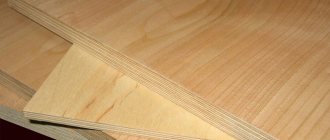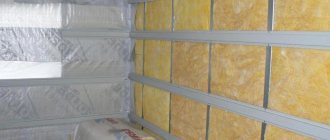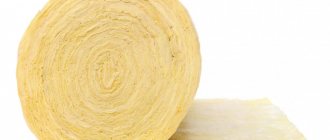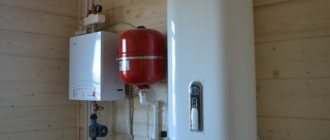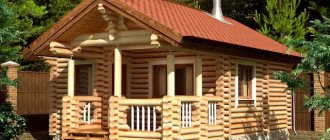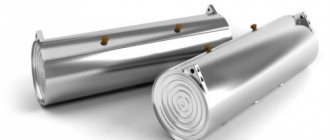Home / Features of various premises / Bathhouse / Using expanded clay for floor insulation in a bathhouse
Building your own bathhouse complex is a difficult task in every sense. Particular attention should be paid to heat conservation and, in particular, to the insulation of surfaces underfoot. One of the frequently used methods of thermal insulation of the floor in a bathhouse is its insulation with expanded clay. This material is very inexpensive and accessible, and therefore popular. At the same time, the technology for using this insulator itself is simple and can be used even by a person who has never carried out such operations before.
Types of expanded clay for insulation
Expanded clay, used as a building material for insulation, has many advantages. According to physical parameters, the material is porous and quite light; it does not create large load effects on the plane. Outwardly, it looks like granules with rounded shapes. The main raw material for production is clay, fired at high temperatures.
This building material is divided into several types.
Expanded clay sand
A finely granulated material used as a filler to reduce the weight of concrete structures. They can be used to insulate the ceiling, spreading it in a layer of up to five centimeters.
Expanded clay sand
Expanded clay gravel
The size of the granules varies from 5 to 40 mm. It is used for the manufacture of structures from lightweight concrete mortars. This type of insulation is used for ceilings, walls and floors of bathhouses.
Walls
Insulation of external walls is extremely rarely carried out separately. After all, it will then lead to improper distribution of heat throughout the material. The walls, floor and ceiling will warm up first, and only then will the air temperature begin to rise. This, of course, is not at all what is expected from a quality bath.
Formally, there is no need for a counter-lattice. But any experienced craftsmen install it to make it easier and faster to create a ventilation duct. The wood must be impregnated with an antiseptic. If installation is on a brick wall, it is advisable to use dowels; they compensate for the excessive rigidity of the structure and speed up installation. Foamed glass is technically perfect, but it turns out to be too expensive to use.
Advantages and disadvantages of expanded clay insulation
The main advantages of this material are:
- high thermal conductivity;
- light weight;
- long operational period reaching fifty years. In this indicator, expanded clay exceeds many insulation materials;
- increased resistance to aggressive chemical environments;
- environmental cleanliness;
- acceptable cost determined by manufacturing costs;
- the material is not biodegradable during operation, does not emit harmful chemicals, and does not reduce thermal properties;
- expanded clay does not attract rodents;
- the ceiling insulated with expanded clay guarantees high fire-resistant quality of the ceiling;
- The insulating material has a high level of frost resistance and is capable of withstanding at least twenty-five freeze-thaw cycles without reducing its thermal insulation qualities.
A clear disadvantage is the difficulty in achieving complete sound insulation. To solve this problem, you have to pour expanded clay in a layer of up to half a meter.
In addition, expanded clay needs additional means to help retain moisture, in the form of vapor and waterproofing. And if the rooms are very damp, it is not possible to insulate them with expanded clay.
We insulate timber floors
For baths that are located on stilts, insulation is also protection that can extend their service life. Therefore, special attention must be paid to its quality and reliability; the installation instructions and other recommendations must be followed.
It should be noted that the manufacture of thermal insulation for wooden floors should consist of the following points:
- The logs are laid on the subfloor;
- The space formed between them is filled with insulation - expanded polystyrene, expanded clay or mineral wool;
- Work is underway to install waterproofing;
- The floorboard is being laid.
Important. When laying boards in this type of bathhouse, you need to maintain a slight slope so that the water drains.
Features of thermal insulation of a bath
Let's look at the main nuances of insulating a bathhouse.
The steam room needs special thermal insulation, since it is in it that the difference in temperature with the environment can reach a hundred degrees or more. It follows from this that the thermal insulation layer must be made of high-quality materials and have the required thickness.
The main points of installing thermal insulation in a steam room are:
- significant difference in temperatures;
- increased level of humidity in the steam room.
Humidity in a steam room can reach maximum levels, and if appropriate measures are not taken, the walls will constantly be wet, which will entail a reduction in the operating period.
Due to the fact that the main goal is to maintain a high temperature, it is necessary to exclude all options for cold air masses getting inside and heat escaping. There are several ways to solve such problems:
- walls and ceilings are insulated;
- eliminates the possibility of heat leakage through the floors;
- The entrance door is finished with insulating material.
To solve the last problem, there are several options:
- the easiest and most inexpensive - precise fit of the door leaf and frame;
- the device of a high threshold (not lower than fifteen centimeters), which will make it difficult for cold air to penetrate into the room;
- dressing room device.
What materials to use
Water will become a problem when insulating the floor. Many materials are not designed for installation in conditions of high humidity. This applies to insulation with high absorption capacity.
For example, it is not allowed to use mineral wool to perform the work. This effective insulation is able to absorb water. When wet, cotton wool stops performing its intended tasks, wrinkles, settles and loses its shape.
For wet rooms, it is recommended to choose materials that are resistant to moisture. These include:
- Styrofoam;
- extruded polystyrene foam (or penoplex);
- penoizol, etc.
Bathhouse insulation technology with expanded clay
The porous structural structure of expanded clay significantly improves its thermal insulation properties. In order to conserve heat indoors as much as possible, you should choose the right not only insulation material, but also insulators.
Ceiling
When deciding on the amount of expanded clay to insulate the bathhouse ceiling, it is necessary to take into account that the minimum layer thickness should be twenty centimeters. The floors of the steam room and other rooms from the attic are insulated. If possible, expanded clay in the form of gravel and sand is used, which gives the backfill layer maximum density.
Insulation of a bathhouse ceiling with expanded clay
All work is carried out in a certain sequence:
- a vapor barrier membrane is laid, the edges overlap by fifteen centimeters. If aluminum foil is chosen for this, then the reflective surface is directed indoors;
- The joining areas are carefully taped with metallized tape. When using roofing felt material, the joints are coated with bitumen mastic;
- the rafters and chimney are vapor barriered above the level of the intended backfill layer. The material is fixed with a construction stapler or masking tape;
- a ten-centimeter layer is made from crushed clay and compacted to improve thermal insulation;
- expanded clay is poured in and leveled;
- the surface of the layer is filled with a screed of sand and cement material.
If the attic is planned for use, then boards can be laid along the beams.
It is not recommended to use expanded clay for ceiling insulation if there is no attic space on site. The fact is that this material can absorb moisture, which negatively affects its thermal insulation abilities. In addition, moisture will make the material heavier, increasing the load on the bathhouse ceiling.
Floor
Insulation of the bathhouse floor with expanded clay is carried out at the stage of construction or repair work. When calculating the layer thickness, it is important to take into account the permissible load forces.
The algorithm of actions is as follows:
- Bituminous waterproofing is spread on the surface of the concrete screed, the edges overlap by ten centimeters. In this case, overhangs of fifteen centimeters are provided on the walls;
- along the entire perimeter of the floor, beacons are fixed in alabaster, determining the thickness of the layer and its evenness;
- if expanded clay is backfilled between logs made of wood material, they are pre-treated with antiseptic agents;
- Expanded clay material is poured fifteen to twenty centimeters thick. It is recommended to use a mixture consisting of different fractions of material;
- the backfill is impregnated with “cement laitance” so that the granules “adhere” to each other;
- on the second day, a reinforcing metal mesh is laid on top so that the structure receives additional strength and rigidity;
- a three-centimeter cement-sand screed is poured and time is given until it dries completely. The end of this process is determined using a glass jar. It is applied with its neck to the floor, if the glass does not fog up, you can move on to the rest of the work;
- a waterproofing layer is attached;
- finishing floor is installed. This type of flooring gains full strength in about one month.
Insulating the floor of a bathhouse with expanded clay
If you decide to insulate the floor with expanded clay on the ground, you will have to create a layer whose thickness is about thirty-five centimeters, which will significantly raise its level. This feature should be taken into account in the process of drawing up project documentation.
Thermal insulation can be done with expanded clay concrete, but this method will not give much effect for the steam room.
The second option for floor insulation is pouring expanded clay into the frame. First of all, a solid base is prepared, then a layer of waterproofing material is laid. After this, the frame is assembled from boards and bars. If the floor area is large, then it is recommended to divide the frame base into several sections, each of which is isolated separately and secured to create a universal structure. Expanded clay is poured in the same way as in the first method. The frame base is hammered with a board on top, and the finishing coating is arranged. A good solution would be to install a membrane base under the boards.
Specifications
The material parameters are established by GOST 9757-90, which regulates the quality of porous building materials
Some indicators are not regulated, but still remain an important characteristic. Let's take a closer look at the main properties of expanded clay
- Factional composition. In total, three fractions of material have been established, having a size range of 5-10 mm, 10-20 mm, 20-40 mm. A separate category includes fractions that are rarely used in construction work. These include expanded clay granules and crushed stone with sizes from 2.5 to 10 mm, as well as a wide mixed fraction from 5 to 20 mm. Thermal insulating expanded clay layers used in the form of bulk mass are a mixture of all fractions - from 5 to 40 mm. This is due to the need to fill voids in the heat-insulating layer, which increases the rigidity of the structure and eliminates convection air currents.
- Expanded clay grades by bulk density (volumetric bulk density). A total of seven values are established: up to 250 kg/m3 - grade 250, from 250 to 300 kg/m3 - grade 300, similarly - grades 350, 400, 450, 500, 600. Grades 700 and 800 are not produced for general sale and are produced only upon agreement with the consumer. True density (true volumetric weight) is 1.5-2 times greater than bulk density. This parameter characterizes the density of the material without taking into account the gaps between granules or fragments of the material;
- Expanded clay grades by strength. For gravel, there are 13 grades, differing in strength when compressed in a cylinder. For crushed stone, 11 grades are standardized, having the same designations as gravel grades. The strength of crushed stone and gravel of the same brand varies. Thus, for grade P100, the compressive strength of gravel is from 2.0 to 2.5 MPa, while crushed stone is from 1.2 to 1.6 MPa. There is a relationship between expanded clay grades in terms of density and strength - an increase in density leads to an increase in strength. The relationship between brands is also regulated by the GOST 9757-90 standard, which eliminates the production of low-quality high-density expanded clay that breaks down under light load.
- Compaction coefficient is a value agreed with the consumer, which does not exceed 1.15 and is used to take into account the compaction of the expanded clay mass as a result of transportation or caking. The use of the coefficient is associated with frequent shipment of material by bulk volume, which is convenient for the sale of large quantities.
- Thermal conductivity is the most important parameter characterizing thermal insulation properties. For expanded clay, the thermal conductivity coefficient ranges from 0.10 to 0.18 W/(m?°C). The range of values is quite narrow, which indicates the high thermal insulation properties of the material. With increasing density, the thermal conductivity coefficient increases. This is due to a decrease in the number and volume of pores containing the main heat insulator - air.
- Water absorption is an important parameter showing the behavior of a material when exposed to water. Expanded clay is a relatively resistant material and is characterized by a water absorption value of 8-20%.
- Sound insulation - like most thermal insulation components, expanded clay has increased sound insulation. The best results are achieved when soundproofing a wooden floor, in which expanded clay acts as a layer between the outer part of the floor and the interfloor slab.
- Frost resistance - due to low water absorption and clay, which is the basis of the material, expanded clay has fairly high frost-resistant properties. Numerical values are not standardized by standards, since expanded clay is frost-resistant “by default.” Only the indicators of building stones that contain expanded clay - expanded clay blocks - are standardized.
The following video will tell you how to calculate how many cubes of expanded clay in a bag:
Tips for choosing insulation
The right choice of insulation is the key to success
The modern market offers a huge number of insulation materials. They differ from each other not only in their technical characteristics, but also in cost. However, you should not rely on the latter when choosing the best option.
The choice of insulation must be made based on:
- Type of flooring. Concrete floors are insulated with penoplex, expanded clay or perlite. The wooden floor is made of penoplex, as this is the only material that does not absorb moisture at all. It is undesirable to lay insulation with a fiber or open cellular structure under it, for example, expanded clay, since in this case it will be necessary to equip a reinforced layer of waterproofing. Penoplex can be replaced with foamed polymers - ecowool or Aisinin foam. Being light in weight, they retain heat well. However, electric, infrared or water heating can be installed under both concrete and wooden floors.
- The premises in which it will be installed. Organic insulation is suitable only for use in rest rooms or in the dressing room, since even treatment with fire retardants does not make them resistant to high temperatures.
- Personal wishes for safety - insulation can be organic and of plant or animal origin (felt, tow, cellulose) and inorganic (foam plastic, mineral wool and glass wool). The latter are produced through the processing of minerals and are characterized by resistance to high temperatures. However, they are inferior in environmental friendliness to organic insulation.
In addition, you need to pay attention to the specific gravity of the insulation itself. A good insulation is one that does not create additional load on the foundation
A little history
Expanded clay owes its appearance to defective bricks. At the beginning of the last century, red brick was produced industrially. When the duration of heat treatment increased or the temperature exceeded the permissible limit, the brick became burnt and swelled. The substandard material was crushed and used as concrete filler.
If in our country bricks unsuitable for construction were not allowed to go to waste, then in America porous clay plates were specially made. And they were used in the same way with our marriage.
The thirties of the 20th century were marked by the fact that this technology was modernized. The Soviet engineer proposed making small porous fractions at once. The clay granules were heat treated in rotary kilns. A durable layer appeared on their surface. The granules were light in weight, since there were many air inclusions inside. This is how expanded clay appeared.
Distinctive features of the washing room and the floor in it
A bathhouse is a building that is highly exposed to water. However, it is the washing room in such a structure that is the room where there is the most moisture. There is also a strong temperature difference here, which is especially noticeable in winter.
Usually a person visits the washing department several times while in the bathhouse. He constantly enters it from the steam room to douse himself with cool water. In this case, the liquid always falls on the floor and leaves through it. Therefore, moisture regularly penetrates into the pores of wooden elements of building structures.
The bathhouse is not heated regularly. For this reason, during the winter, the water in the lumber periodically thaws and freezes. Therefore, there is a gradual destruction of the wood from which the floor parts and other building structures are made.
Excess moisture negatively affects all wooden elements of the washing machine Source vip-1gl.ru
Due to changes in temperature and constant humidity in the washing room, special requirements are placed on the floor in this room:
- effective drainage of water by installing a slope to the drain ladder or constructing a leaky structure;
- high resistance to rot and sudden temperature changes;
- minimal ability to absorb moisture and greater strength;
- maximum heating and drying in a short period of time;
- anti-slip surface even when very wet.
It is possible to meet all the requirements only if the floor is constructed correctly. Therefore, even at the stage of designing a bathhouse, it is necessary to choose its design wisely. To avoid mistakes and anticipate all possible difficulties in advance, it is better to contact a specialized company.
Specialists are able to fully solve the problem. They will create ventilation in the washing room and professionally select all the necessary building materials, which will allow the use of high-quality thermal insulation.
Using high-quality building materials in bathhouse cleaning Source remontik.org
If the floor in the washing room has a lower temperature than the air in the upper zone of this room, then people will feel uncomfortable during water procedures. This deficiency also negatively affects the microclimate of the room and contributes to the occurrence of rot on the wood. To eliminate these problems, experts recommend high-quality thermal insulation of the floor structure.
Conclusion
Despite the fact that croaker is only a waste product for sawmills, this material can be used in many different ways. After all, it consists of wood, which means that in certain conditions it can effectively replace more expensive lumber.
After reading the article and watching photos and videos, you learned how to build a country house, barn, garage or bathhouse with your own hands from slab, how to use it in cladding, making furniture and various products, what else can be made from this material, and how to build a business.
Sources
- https://strofix.ru/bath-houses-and-saunas/61-stroim-banyu-iz-podruchnyh-materialov.html
- https://vbanepar.ru/banya-karkasnaya-svoimi-rukami.html
- https://texnotoys.ru/materialy/banya-zasypnaya-opilkami.html
- https://parilochka.com/banya/iz-dosok
- https://iobogrev.ru/zasypnaja-banja-iz-opilok-svoimi-rukami
Pros - cons
The advantages of such insulators are sufficient for this material, which has been used for quite some time, to still remain popular:
In addition to the advantages, backfilling of this type will also have several disadvantages. First of all, it is worth noting that the expanded clay layer needs to be thick enough for good heat conservation. It is this drawback that becomes an obstacle to its wider use. The second disadvantage will be moisture absorption. The material gets wet quite actively, but on the contrary, it dries very poorly. Therefore, it is always necessary to waterproof it from the bottom and top sides.
Recommendations
Attention should also be paid to floors that are fixed to pile foundations. Stages of work:
- Tie the pile heads together with special screw beams.
- Lay a layer of waterproofing on a wooden base made of beams.
- Place rough timbers on the lower sides of the beams.
- Lay sheets of thermal insulation and cover them with waterproofing film.
- Apply a finishing coat.
It is important not to confuse the method of laying the waterproofing film. Instructions are present on the packaging. Concrete floors in bath rooms need to be insulated
If this is not done, they will be very cold despite the heating of the rooms. For thermal insulation, you need to choose one of several types of materials. It is important to take into account the features of insulation when carrying out work independently
Concrete floors in bathhouses need to be insulated. If this is not done, they will be very cold despite the heating of the rooms. For thermal insulation you need to choose one of several types of materials
It is important to take into account the features of insulation when carrying out work independently
Pile structures for the foundation
Often a bathhouse is built on piles, which represent a supporting structure and are used for installation under a log house. This is considered the simplest type of foundation. When insulating a bathhouse on stilts, there is one significant advantage - reliable waterproofing of the foundation itself by raising it above the ground. Most often, piles are represented by long metal pipes with blades that cut the soil.
After constructing the foundation on the piles, you need to lay a wooden covering, which itself will retain heat in the bathhouse. However, wooden flooring alone is not enough - it is necessary to make a base from a pipe that will connect all the screw piles, and then waterproof it with film.
Mineral wool tiles can be used as insulation between the film and the boards. External thermal insulation is carried out along the contour of the base using fasteners. After completion of the work, you can begin finishing the facade.
Insulation work in the steam room
Unlike a washing room, in a steam room the level of humidity is tolerable, so almost any type of heat insulator can be used to insulate the base. But in this case, the temperature regime deserves special attention. Due to exposure to high temperatures, some synthetic materials may emit formaldehyde, which is unacceptable.
What is the best way to insulate floors in a steam room? Thermal insulation of the base in such rooms should be done with foam plastic or expanded clay, as shown in the photo. In this case, the thickness of the insulating layer should be at least 10, or even 15 cm, as is the case with expanded clay.
Briefly about the main thing
The washing room is distinguished by the presence of a large amount of used water, which constantly freezes in winter and periodically thaws in the pores of the wooden elements in the bathhouse. Because of this, they begin to rot. To eliminate the shortcoming, the floor is insulated. This also helps reduce sudden temperature changes.
The washroom has a tiled floor with a concrete base, a solid wooden or pouring floor. All structures are insulated. Depending on the type of floor, foam plastic, mineral wool, penoplex, perlite or expanded clay can be used. Often in the washing department they create a floating screed on a wooden base or pour a completely concrete floor on the ground.
Ratings 0

